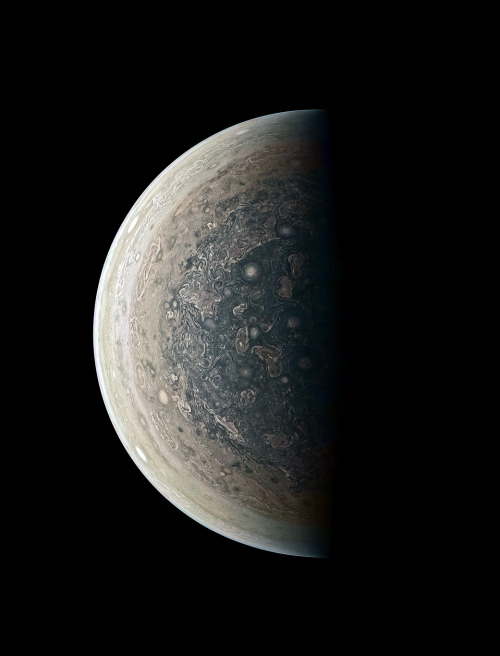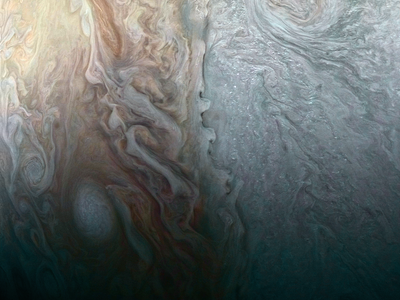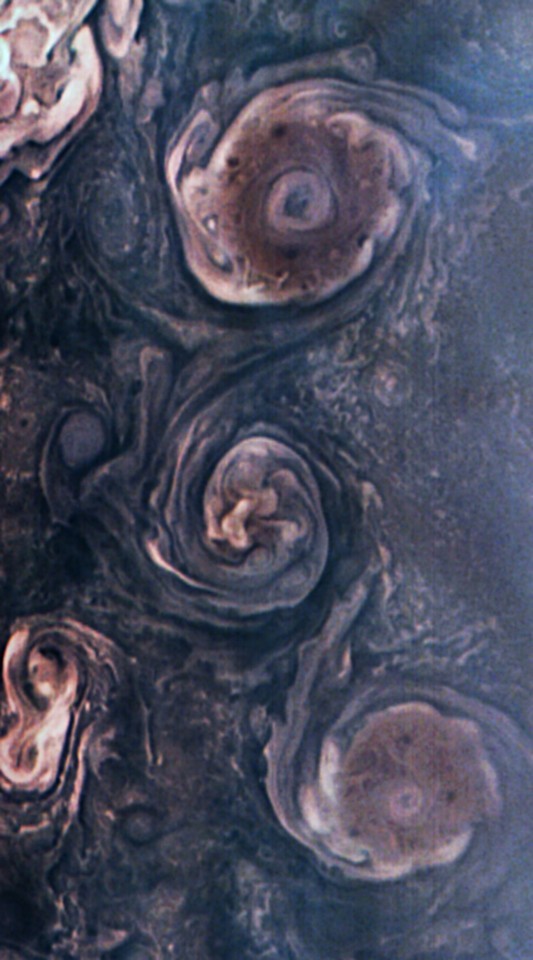“Breakfast On Mars” By Simon Kono.

“Breakfast on Mars” by Simon Kono.
More Posts from Maevetheeuropan and Others

Lockheed Martin joins the space race to Mars
From China to NASA to Elon Musk, it seems everyone has their sights set on Mars exploration. But before we land on the Red Planet, we’ll probably orbit it. At this week’s Humans to Mars summit, Lockheed Martin unveiled its Mars Base Camp concept — an ambitious plan to send a manned space laboratory to orbit Mars by 2028.
Solar System: Things to Know This Week
There’s even more to Mars.

1. Batten Down the Hatches
Good news for future astronauts: scientists are closer to being able to predict when global dust storms will strike the Red Planet. The winds there don’t carry nearly the same force that was shown in the movie “The Martian,” but the dust lofted by storms can still wreak havoc on people and machines, as well as reduce available solar energy. Recent studies indicate a big storm may be brewing during the next few months.
+ Get the full forecast

2. Where No Rover Has Gone Before
Our Opportunity Mars rover will drive down an ancient gully that may have been carved by liquid water. Several spacecraft at Mars have observed such channels from a distance, but this will be the first up-close exploration. Opportunity will also, for the first time, enter the interior of Endeavour Crater, where it has worked for the last five years. All this is part of a two-year extended mission that began Oct. 1, the latest in a series of extensions going back to the end of Opportunity’s prime mission in April 2004. Opportunity landed on Mars in January of that year, on a mission planned to last 90 Martian days (92.4 Earth days). More than 12 Earth years later, it’s still rolling.
+ Follow along + See other recent pictures from Endeavour Crater

3. An Uphill Climb
Opportunity isn’t the only NASA Mars rover getting a mission extension. On the other side of the planet, the Curiosity rover is driving and collecting samples amid some of the most scenic landscapes ever visited on Mars. Curiosity’s two-year mission extension also began Oct. 1. It’s driving toward uphill destinations, including a ridge capped with material rich in the iron-oxide mineral hematite, about a mile-and-a-half (two-and-a-half kilometers) ahead. Beyond that, there’s an exposure of clay-rich bedrock. These are key exploration sites on lower Mount Sharp, which is a layered, Mount-Rainier-size mound where Curiosity is investigating evidence of ancient, water-rich environments that contrast with the harsh, dry conditions on the surface of Mars today.
+ Learn more

4. Keep a Sharp Lookout
Meanwhile, the Mars Reconnaissance Orbiter continues its watch on the Red Planet from above. The mission team has just released a massive new collection of super-high-resolution images of the Martian surface.
+ Take a look

5. 20/20 Vision for the 2020 Rover
In the year 2020, Opportunity and Curiosity will be joined by a new mobile laboratory on Mars. In the past week, we tested new “eyes” for that mission. The Mars 2020 rover’s Lander Vision System helped guide the rocket to a precise landing at a predesignated target. The system can direct the craft toward a safe landing at its primary target site or divert touchdown toward better terrain if there are hazards in the approaching target area.
+ Get details
Discover the full list of 10 things to know about our solar system this week HERE.
Make sure to follow us on Tumblr for your regular dose of space: http://nasa.tumblr.com

From astrophysicist Katie Mack. I’m 100% behind her.
NASA Technology in Your Life
How does NASA technology benefit life on Earth? It probably has an impact in more ways than you think! Since 1976, our Spinoff program has profiled nearly 2,000 space technologies that have transformed into commercial products and services. In celebration of Spinoff’s 40th year of publication, we’ve assembled a collection of spinoffs that have had the greatest impact on Earth.
Take a look and see how many you utilize on a regular basis:
Digital Image Sensors

Whether you take pictures and videos with a DSLR camera or a cell phone, or even capture action on the go with a device like a GoPro Hero, you’re using NASA technology. The CMOS active pixel sensor in most digital image- capturing devices was invented when we needed to miniaturize cameras for interplanetary missions. This technology is also widely used in medical imaging and dental X-ray devices.
Enriched Baby Formula

While developing life support for Mars missions, NASA-funded researchers discovered a natural source for an omega-3 fatty acid previously found primarily in breast milk that plays a key role in infant development. The ingredient has since been added to more than 90% of infant formula on the market and is helping babies worldwide develop healthy brains, eyes and hearts.
NASTRAN Software

NASTRAN is a software developed by our engineers that performs structural analysis in the 1960s. Still popular today, it’s been used to help design everything from airplanes and cars to nuclear reactors and even Disney’s Space Mountain roller coaster.
Food Safety Standards

Looking to ensure the absolute safety of prepackaged foods for spaceflight, we partnered with the Pillsbury Company to create a new, systematic approach to quality control. Now known as Hazard Analysis and Critical Control Points (HACCP), the method has become an industry standard that benefits consumers worldwide by keeping food free from a wide range of potential chemical, physical and biological hazards.
Neutral Body Posture Specifications

What form does the human body naturally assume when all physical influences, including the pull of gravity, stop affecting it? We conducted research to find out using Skylab, America’s first space station, and later published specifications for what it called neutral body posture. The study has informed seat designs in everything from airplanes and office chairs to several models of Nissan automobiles.
Advanced Water Filtration

We recently discovered unexpected sources of water on the moon and Mars, but even so, space remains a desert for human explorers, and every drop must be recycled and reused. A nano filter devised to purify water in orbit is currently at work on Earth, in devices that supply water to remote villages as well as in a water bottle that lets hikers and adventurers stay hydrated using streams and lakes.
Swimsuit Designs

Wind-tunnel testing at our Langley Research Center played a key role in the development of Speedo’s LZR Racer swimsuit, proving which materials and seams best reduced drag as a swimmer cuts through the water. The swimsuit made a splash during its Olympic debut in 2008, as nearly every medal winner and world-record breaker wore the suit.
Air Purifier

When plants grow, they release a gas called ethylene that accelerates decay, hastening the wilting of flowers and the ripening of fruits and vegetables. Air circulation on Earth keeps the fumes from building up, but in the hermetically sealed environment of a spacecraft, ethylene poses a real challenge to the would-be space farmers. We funded the development of an ethylene scrubber for the International Space Station that has subsequently proved capable of purifying air on Earth from all kinds of pathogens and particulates. Grocery stores use it to keep produce fresh longer. It’s also been marketed for home use and has even been embraced by winemakers, who employ the scrubber to keep aging wine in barrels free from mold, mildew and musty odors.
Scratch-Resistant, UV-Reflective Lenses

Some of the earliest research into effective scratch-resistant coatings for prescription and sunglass lenses drew from work done at Ames Research Center on coatings for astronaut helmet visors and plastic membranes used in water purification systems. In the 1980s, we developed sunlight-filtering lenses to provide eye protection and enhance colors, and these lenses have found their way into sunglasses, ski goggles and safety masks for welders.
Dustbuster

An Apollo-era partnership with Black & Decker to build battery-operated tools for moon exploration and sample collection led to the development of a line of consumer, medical and industrial hand-held cordless tools. This includes the popular Dustbuster cordless vacuum.
To see even more of our spinoff technologies, visit: http://www.nasa.gov/offices/oct/40-years-of-nasa-spinoff
Make sure to follow us on Tumblr for your regular dose of space: http://nasa.tumblr.com









Images of Jupiter taken by JunoCam on NASA’s Juno spacecraft.

Mission Juno
Juno is a NASA spacecraft. It is exploring the planet Jupiter. Juno launched from Earth in 2011. It reached Jupiter in 2016. That was a five-year trip!
The name “Juno” comes from stories told by the Romans long ago. In the stories, Juno was the wife of Jupiter. Jupiter hid behind clouds so no one could see him causing trouble. But Juno could see through the clouds.
Juno has science tools to study Jupiter’s atmosphere. (The atmosphere is the layer of gases around a planet.) Juno will take the first pictures of Jupiter’s poles. The spacecraft will study the lights around Jupiter’s north and south poles, too.
Juno will help scientists understand how Jupiter was made. The spacecraft will help them learn how Jupiter has changed, too. The new discoveries can help us understand more about our solar system.
Sound of Jupiter’s Magnetosphere: Click here
Credit: NASA / JPL-Caltech / Mission Juno / Jason Major / Luca Fornaciari / Gerald Eichstädt
Getting to Mars: What It’ll Take
Join us as we take a closer look at the next steps in our journey to the Red Planet:
The journey to Mars crosses three thresholds, each with increasing challenges as humans move farther from Earth. We’re managing these challenges by developing and demonstrating capabilities in incremental steps:
Earth Reliant

Earth Reliant exploration is focused on research aboard the International Space Station. From this world-class microgravity laboratory, we are testing technologies and advancing human health and performance research that will enable deep space, long duration missions.
On the space station, we are advancing human health and behavioral research for Mars-class missions. We are pushing the state-of-the-art life support systems, printing 3-D parts and analyzing material handling techniques.
Proving Ground

In the Proving Ground, we will learn to conduct complex operations in a deep space environment that allows crews to return to Earth in a matter of days. Primarily operating in cislunar space (the volume of space around the moon). We will advance and validate the capabilities required for humans to live and work at distances much farther away from our home planet…such as at Mars.
Earth Independent

Earth Independent activities build on what we learn on the space station and in deep space to enable human missions to the Mars vicinity, possibly to low-Mars orbit or one of the Martian moons, and eventually the Martian surface. Future Mars missions will represent a collaborative effort between us and our partners.

Did you know….that through our robotic missions, we have already been on and around Mars for 40 years! Taking nearly every opportunity to send orbiters, landers and rovers with increasingly complex experiments and sensing systems. These orbiters and rovers have returned vital data about the Martian environment, helping us understand what challenges we may face and resources we may encounter.

Through the Asteroid Redirect Mission (ARM), we will demonstrate an advanced solar electric propulsion capability that will be a critical component of our journey to Mars. ARM will also provide an unprecedented opportunity for us to validate new spacewalk and sample handling techniques as astronauts investigate several tons of an asteroid boulder.
Living and working in space require accepting risks – and the journey to Mars is worth the risks. A new and powerful space transportation system is key to the journey, but we will also need to learn new ways of operating in space.
We Need You!

In the future, Mars will need all kinds of explorers, farmers, surveyors, teachers…but most of all YOU! As we overcome the challenges associated with traveling to deep space, we will still need the next generation of explorers to join us on this journey. Come with us on the journey to Mars as we explore with robots and send humans there one day.
Join us as we go behind-the-scenes:
We’re offering a behind-the-scenes look Thursday, Aug. 18 at our journey to Mars. Join us for the following events:
Journey to Mars Televised Event at 9:30 a.m. EDT Join in as we host a conversation about the numerous efforts enabling exploration of the Red Planet. Use #askNASA to ask your questions! Tune in HERE.
Facebook Live at 1:30 p.m. EDT Join in as we showcase the work and exhibits at our Michoud Assembly Facility. Participate HERE.
Hot Fire Test of an RS-25 Engine at 6 p.m. EDT The 7.5-minute test is part of a series of tests designed to put the upgraded former space shuttle engines through the rigorous temperature and pressure conditions they will experience during a launch. Watch HERE.
Make sure to follow us on Tumblr for your regular dose of space: http://nasa.tumblr.com

That’s tonight fyi
Okay now that I’m starting to get my ass in gear for astrophotography, I’d love it if some of y’all sated my need for attention and followed my instagram! I will return the favor of course
It’s mostly just space pictures, dogs, me, hiking stuff and lab stuff
-
 eyesonstars-feetonground liked this · 4 years ago
eyesonstars-feetonground liked this · 4 years ago -
 eyesonstars-feetonground reblogged this · 4 years ago
eyesonstars-feetonground reblogged this · 4 years ago -
 cheshirecaine reblogged this · 4 years ago
cheshirecaine reblogged this · 4 years ago -
 tearsyouwillcry reblogged this · 4 years ago
tearsyouwillcry reblogged this · 4 years ago -
 bizarrobrain liked this · 7 years ago
bizarrobrain liked this · 7 years ago -
 yesitsanusha reblogged this · 7 years ago
yesitsanusha reblogged this · 7 years ago -
 archon857 liked this · 7 years ago
archon857 liked this · 7 years ago -
 iimanar-blog reblogged this · 7 years ago
iimanar-blog reblogged this · 7 years ago -
 shyhermit liked this · 7 years ago
shyhermit liked this · 7 years ago -
 number--42 reblogged this · 8 years ago
number--42 reblogged this · 8 years ago -
 unwoundandrewoundagain reblogged this · 8 years ago
unwoundandrewoundagain reblogged this · 8 years ago -
 unwoundandrewoundagain liked this · 8 years ago
unwoundandrewoundagain liked this · 8 years ago -
 hemulpajun liked this · 8 years ago
hemulpajun liked this · 8 years ago -
 brtmb549 liked this · 8 years ago
brtmb549 liked this · 8 years ago -
 imagoetimago reblogged this · 8 years ago
imagoetimago reblogged this · 8 years ago -
 imagoetimago liked this · 8 years ago
imagoetimago liked this · 8 years ago -
 bellusverus reblogged this · 8 years ago
bellusverus reblogged this · 8 years ago -
 bellusverus liked this · 8 years ago
bellusverus liked this · 8 years ago -
 timelesssoliton reblogged this · 8 years ago
timelesssoliton reblogged this · 8 years ago -
 concrete-religion liked this · 8 years ago
concrete-religion liked this · 8 years ago -
 kbrylm liked this · 8 years ago
kbrylm liked this · 8 years ago -
 mybuddy-mybucky liked this · 8 years ago
mybuddy-mybucky liked this · 8 years ago -
 struggle7 reblogged this · 8 years ago
struggle7 reblogged this · 8 years ago -
 sylfir reblogged this · 8 years ago
sylfir reblogged this · 8 years ago -
 rzanas7 reblogged this · 8 years ago
rzanas7 reblogged this · 8 years ago -
 6289 reblogged this · 8 years ago
6289 reblogged this · 8 years ago -
 some-dizzy-whore-1804 reblogged this · 8 years ago
some-dizzy-whore-1804 reblogged this · 8 years ago -
 some-dizzy-whore-1804 liked this · 8 years ago
some-dizzy-whore-1804 liked this · 8 years ago -
 lawsonpines13 reblogged this · 8 years ago
lawsonpines13 reblogged this · 8 years ago -
 3zmohad-blog reblogged this · 8 years ago
3zmohad-blog reblogged this · 8 years ago -
 6289 reblogged this · 8 years ago
6289 reblogged this · 8 years ago -
 cosmictangerines liked this · 8 years ago
cosmictangerines liked this · 8 years ago -
 kazije-blog reblogged this · 8 years ago
kazije-blog reblogged this · 8 years ago -
 camilo72 liked this · 8 years ago
camilo72 liked this · 8 years ago -
 aewyrn reblogged this · 8 years ago
aewyrn reblogged this · 8 years ago -
 maevetheeuropan reblogged this · 8 years ago
maevetheeuropan reblogged this · 8 years ago -
 noramalik liked this · 8 years ago
noramalik liked this · 8 years ago -
 6lvck9 liked this · 8 years ago
6lvck9 liked this · 8 years ago -
 jordanhii-blog reblogged this · 8 years ago
jordanhii-blog reblogged this · 8 years ago








